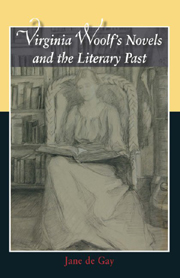Book contents
- Frontmatter
- Contents
- Acknowledgements
- Abbreviations
- Introduction
- 1 From Woman Reader to Woman Writer: The Voyage Out
- 2 Tradition and Exploration in Night and Day
- 3 Literature and Survival: Jacob's Room and Mrs Dalloway
- 4 To the Lighthouse and the Ghost of Leslie Stephen
- 5 Rewriting Literary History in Orlando
- 6 ‘Lives Together’: Literary and Spiritual Autobiographies in The Waves
- 7 Bringing the Literary Past to Life in Between the Acts
- Conclusion
- Select Bibliography
- Index
6 - ‘Lives Together’: Literary and Spiritual Autobiographies in The Waves
Published online by Cambridge University Press: 12 September 2012
- Frontmatter
- Contents
- Acknowledgements
- Abbreviations
- Introduction
- 1 From Woman Reader to Woman Writer: The Voyage Out
- 2 Tradition and Exploration in Night and Day
- 3 Literature and Survival: Jacob's Room and Mrs Dalloway
- 4 To the Lighthouse and the Ghost of Leslie Stephen
- 5 Rewriting Literary History in Orlando
- 6 ‘Lives Together’: Literary and Spiritual Autobiographies in The Waves
- 7 Bringing the Literary Past to Life in Between the Acts
- Conclusion
- Select Bibliography
- Index
Summary
Woolf considered The Waves to be the novel which came closest to capturing her own ideas and establishing her own style. When exploring her earliest ideas for the work, she noted a desire to write a book which was ‘made solely & with integrity of one's thoughts’ (D, III. 102), and after finishing it, she noted, ‘I think I am about to embody, at last, the exact shapes my brain holds. What a long toil to reach this beginning – if The Waves is my first work in my own style!’ (D, IV. 53). Although these statements may appear to be declarations of originality or expressions of a Bloomian desire to overcome the anxiety of influence, the reverse is true. Woolf's comments on her style are couched in provisional, exploratory terms (‘I think …’; ‘if The Waves is …’), suggesting a writerly identity which was in process rather than achieved. The novel itself is profoundly polyphonic, for its prose enfolds many earlier texts in a variety of subtle ways: quotations are absorbed very deeply into the fabric of the novel, with very few being offset or placed in quotation marks; there is much paraphrasing of famous texts; and well-known literary moments (like the mysterious laughter in Jane Eyre (W, 207)) are replayed as part of the characters' experiences. In other words, in expressing her thoughts or ‘the shapes [her] brain holds’ (not ‘produces’), Woolf inevitably expressed the works which formed an important part of her mental landscape, for reading was integral to her intellectual life.
- Type
- Chapter
- Information
- Virginia Woolf's Novels and the Literary Past , pp. 160 - 185Publisher: Edinburgh University PressPrint publication year: 2006



